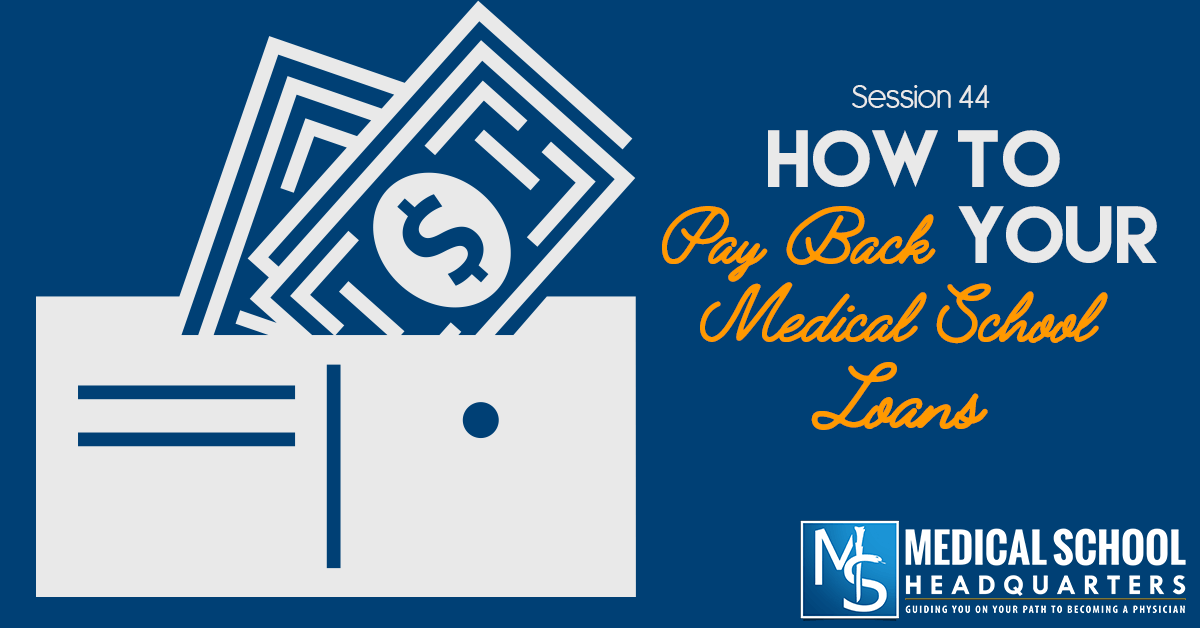
In today’s episode, I talk with Tony Sozzo for the second time on the show, this time about how to pay back your medical school loans.
We talk about the different options available for loan repayment, how they each impact your bank account at the end of the day, and some things you need to consider.
You may not appreciate this topic as a premed, but this information will come in handy eventually. You need to understand what it’s like on the other side of medical school as you’re paying back several hundred thousand dollars worth of student loans.
Listen to this podcast episode with the player above, or keep reading for the highlights and takeaway points.
[Related episode: Interview with a Director of Student Financial Planning.]
Don’t focus on tuition costs when choosing a medical school. You have to go deeper than that. A $10,000-difference over the course of your lifetime isn’t going to make that much of a difference.
Instead, look into these considerations:
[Related episode: How to Choose a Medical School and Put Together a School List.]
For any type of repayment plan, you want to leave yourself with as many options as possible. Options make loan repayment work in your life.
For example, if you have a debt of $170,000 and you want to pay it over a period of 10 years (120 months), you will have a very high monthly payment. Extend that to 25-30 years, and you have a lower monthly payment because it’s stretched out. But you will pay more interest over time.
It’s the cheapest plan in terms of the interest paid. With the 25-year plan, more interest is added even if you have a lower monthly payment.
How much do you have left to pay back your loans on a resident’s salary? Not very much.
How much do you have left to pay back your loans on a resident's salary? Not very much.Click To TweetIncome-based repayment plans, income-driven plans, or Pay-As-You-Earn (PAYE):
View a government website explanation of these repayment plans here.
*Remember, this is based on your income, so if your income increases, your minimum monthly payments may increase, as well.
These income-based repayment plans give you breathing room with modest loan repayments. But keep in mind that these are all U.S. government plans and only apply to federal student loans, not private loans.
Income-based repayment plans give you breathing room with modest loan repayments.Click To TweetWith some of these repayment plans, the government will forgive your debt after a certain number of payments, which is great! However, you may be taxed on the amount forgiven.
[Related episode: Don’t Count on Public Service Loan Forgiveness.]
Protections exist for graduating physicians who fail to match into residency spots their first year.

Lorem ipsum dolor sit amet, consectetur adipiscing elit
I just received my admission to XXXXX! This is unreal and almost feels like I am dreaming. I want to thank you for all of your help with my application. I cannot overstate how influential your guidance and insight have been with this result and I am eternally grateful for your support!
IM SO HAPPY!!!! THANK YOU SO MUCH FOR ALL YOUR HELP, IM INDEBTED TO YOU! Truly, thank you so much for all your help. Thank you doesnt do enough.
I want to take a few moments and thank you for all of your very instructive, kind and consistent feedback and support through my applications and it is your wishes, feedback, and most importantly your blessings that have landed me the acceptance!
I got into XXXXX this morning!!!! It still has not hit me that I will be a doctor now!! Thank you for all your help, your words and motivation have brought me to this point.
I wanted to once again express my heartfelt gratitude for your help in providing feedback during my secondary applications. Your guidance has been instrumental in my journey.
Just wanted to share my wonderful news! I received my first medical school acceptance! Thank you for all that you do for us Application Academy!!!
I am excited to tell you that I just got my third interview invite from XXXXX today! I can’t believe it. I didn’t even know if I was good enough to get one, let alone three – by mid-September. Thank you so much for all of your help and support up to this point; I would not be in this position without it!!
I wanted to thank you for helping me prepare for my XXXXX interview. Even in a 30-minute advising session, I learned so much from you. Thank you for believing in me, and here’s to another potential success story from one of your advisees!
I just received an acceptance with XXXXX! This is so exciting and such a huge relief and so nice to have one of our top choice schools! I also received an interview with XXXXX which brings the total up to 20 interviews! Thank so much, none of this would have been possible without you!

Join our newsletter to stay up to date
* By subscribing you agree to with our Privacy Policy and provide consent to receive updates from our company.
Resources
Advising Services
Podcasts & Youtube
Books
About
"*" indicates required fields